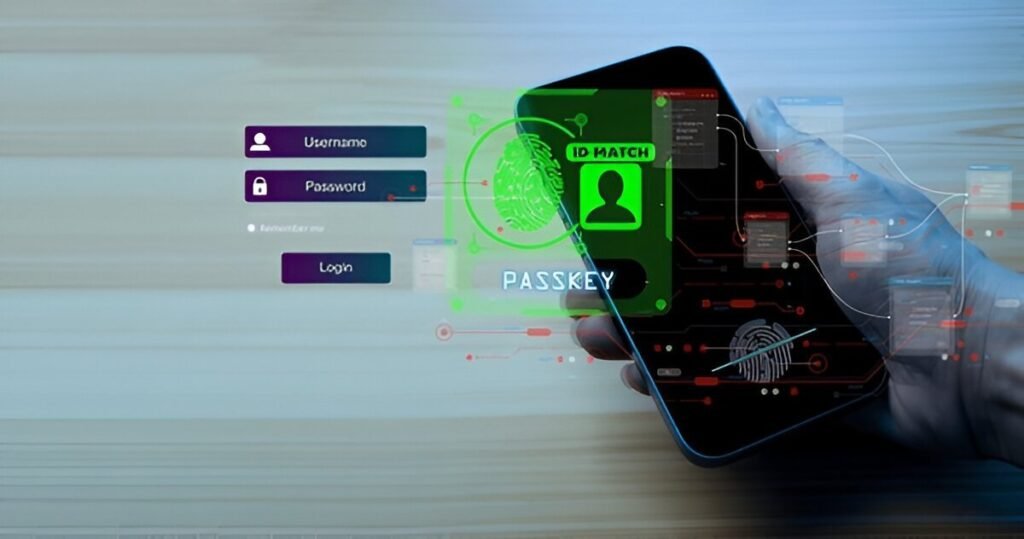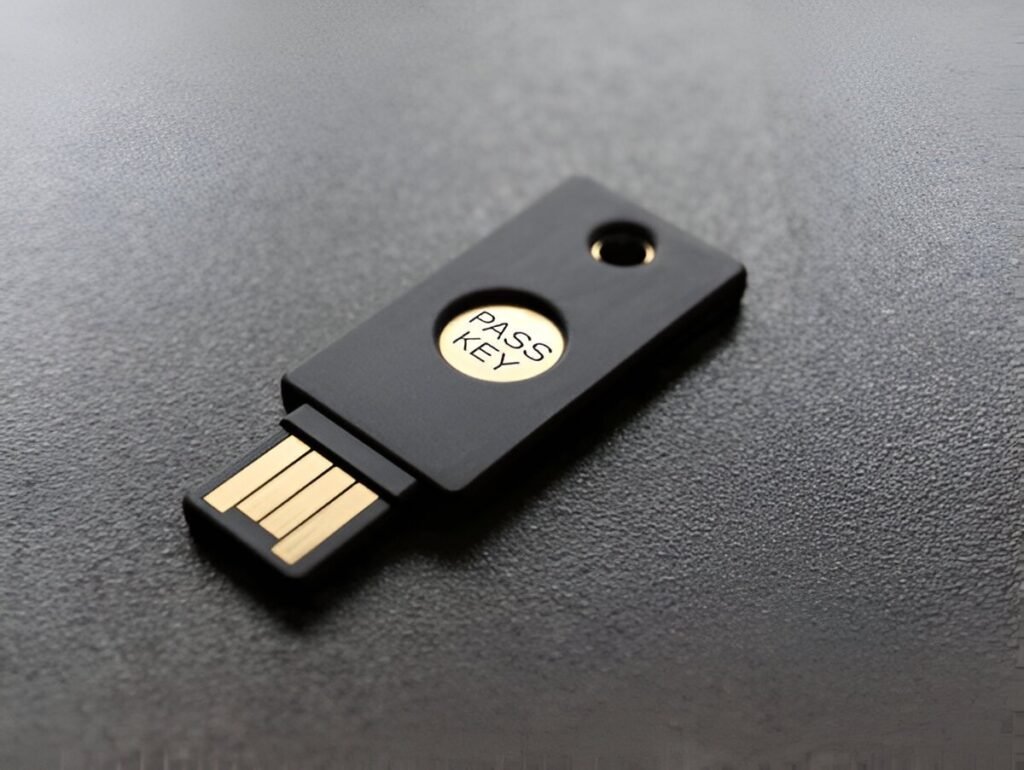Passkeys are changing the way we log in. For decades, passwords have been our digital keys—complex strings we’re expected to create, remember, and update regularly. But passwords are flawed. What is a passkey, then? It’s a new kind of credential designed to replace passwords by offering stronger security and ease of use. Passwords are easily stolen, reused across sites, and prone to phishing attacks. Despite password managers and multi-factor authentication, the system still leaves much to be desired.
Now, there’s a better way. Passkeys are a new form of login technology that replaces traditional passwords with cryptographic keys. They’re more secure, easier to use, and designed to eliminate the very problems passwords created. Built on standards like FIDO2 and WebAuthn, passkeys can verify your identity using biometric methods like fingerprint or facial recognition—no typing required.
Already, big players are already on board. Apple, Google, Microsoft, and other tech giants are rolling out passkey support across platforms. From signing in to your email to accessing your bank account, passkeys are poised to make our online lives safer and more seamless than ever before. In this article, we’ll explore what passkeys are, how they work, why they matter, and how you can start using them today.
What Are Passkeys?
Today, passkeys are a modern replacement for passwords. Instead of typing in a secret word or phrase, you use a digital key that is stored securely on your device. This key is tied to your identity and device, and it authenticates you with a single tap, fingerprint, or facial scan.
Think of a passkey as your personal access card. It’s based on public-key cryptography, where a private key stays on your device and a public key is shared with the service you want to log into. When you try to sign in, the service sends a challenge that your private key answers—proving it’s really you without ever exposing the key itself.
What makes this powerful is how seamless it feels. No need to remember or reset passwords, no phishing traps, no one stealing your credentials from a data breach. Just your face, your fingerprint, or your device—and you’re in.
How Do Passkeys Work?
At first glance, passkeys may feel like magic — a simple tap or fingerprint and you’re in — but behind that ease lies an elegant and robust cryptographic system. To understand what is a passkey and why passkeys are being hailed as the future of authentication, we need to take a quick peek under the hood. Knowing how they work not only helps us trust them more but also reveals why they’re far more secure than traditional passwords.
At the heart of it, passkeys reply on a clever use of public and private key pairs — a technology that’s been used for decades in secure systems but is now being made friendly enough for everyday use. This invisible handshake between your device and the website or app you’re accessing removes the risks that come with passwords: phishing, reuse, and data leaks. So, if you’re wondering what is a passkey exactly, it’s this seamless, secure interaction that makes them so powerful. Let’s break it down.

1. Based on Public-Key Cryptography
At the heart of passkeys is a security system called public-key cryptography. Here’s how it works in plain English:
- When you sign up for a service that supports passkeys, your device creates a key pair — one private and one public.
- The private key stays on your device. It’s like your personal vault key — it never leaves.
- The public key is shared with the website or app. Think of it as the lock they install on their end.
When you want to log in, the site sends a special challenge to your device. Your device uses your private key to prove it’s you. If it checks out, you’re in.
2. Stored on Your Device, Secured by Biometrics
Specifically, your private key is stored locally, often inside secure hardware on your phone, tablet, or laptop (like the Secure Enclave on iPhones or TPM on Windows devices).
To unlock it, you’ll usually authenticate with:
- 👱🏻 Face ID
- ✋ Fingerprint
- 🔢 Device PIN or pattern
This makes it super hard for hackers to get in — even if they know your username, they can’t fake your biometrics or steal your private key remotely.
3. Syncs Across Devices (Sometimes)
In ecosystems like Apple, Google, and Microsoft, your passkeys can sync securely across your devices via cloud services (iCloud Keychain, Google Password Manager, etc.). So if you get a new phone, your keys come with you.
However, even without syncing, passkeys can still work on one device — or be transferred via a QR code or Bluetooth handshake.
Ultimately, passkeys combine top-tier security with a smooth user experience. It’s like magic — but backed by some of the strongest digital protection around.
Why Passkeys Matter: The Problem with Passwords
Passwords Are Broken — Here’s Why:
Despite being the foundation of online security for decades, passwords have always had serious flaws:
- Hard to Remember: Strong passwords are long, complex, and easy to forget. Weak ones are reused and easy to guess.
- Phishing Attacks: Hackers often trick users into typing passwords into fake websites.
- Password Leaks: Databases get breached, exposing millions of login credentials.
- Reuse Across Sites: People tend to reuse the same password on multiple platforms — a hacker only needs to break into one.
Even two-factor authentication (2FA) isn’t perfect — SMS codes can be intercepted, and apps can be spoofed.
Why Passkeys Fix This
Passkeys solve these problems elegantly:
- No password to type or remember.
- No way to be tricked into sharing them — passkeys are phishing-resistant.
- Even if a website is hacked, your passkey is not stored on their servers.
- Your credentials are tied to your device + your biometric — making impersonation nearly impossible.
This isn’t just a better way to log in — it’s a paradigm shift in how we protect our digital lives.
Real-World Adoption: Who’s Using Passkeys Today?
As the tech world gradually shifts away from passwords, passkeys have quietly started taking over — not in theory, but in practice. This isn’t just a promising idea for the future; it’s a reality that’s unfolding today, right on our devices. Companies that shape the digital ecosystem are already adopting passkeys, signaling a massive change in how we think about security and access.
What’s more, this transition is happening faster than most people realize. Behind the scenes, millions of users are logging in without passwords thanks to passkeys — and they’re not even noticing the change. That’s how seamless and powerful this new standard is. Let’s take a closer look at which companies are making it happen.
Tech Giants Are Leading the Way
Passkeys aren’t some distant concept — they’re already here, and major companies are embracing them:
- Apple: Integrated passkey support into iOS, iPadOS, and macOS. You can use Face ID or Touch ID to log in seamlessly.
- Google: Announced full passkey support across Google Accounts and Android devices. As of 2024, they made passkeys the default login option.
- Microsoft: Committed to a passwordless future via Windows Hello and Microsoft Authenticator.
Together, these three control most of the world’s operating systems, browsers, and cloud services — meaning the passkey infrastructure is baked into the tech we already use.
Others Are Following Fast
Beyond the big three:
- PayPal, eBay, Adobe, Best Buy, and even Uber are already rolling out passkey logins.
- Password managers like 1Password and Dashlane now support storing and syncing passkeys.
- Browsers such as Chrome, Safari, and Edge natively support passkeys, making the experience smooth and cross-platform.
The result? Millions of users are already logging in with passkeys without even realizing it — and the number grows daily.
How Passkeys Work: The Tech Behind the Simplicity
While passkeys feel effortless for users, their strength lies in an advanced yet invisible layer of security technology. Understanding how they work helps us appreciate why they’re more than just a convenience — they’re a revolution in digital safety.
The Cryptographic Foundation
At the core of passkeys is public-key cryptography, a battle-tested security method used in everything from secure messaging apps to online banking. When a user creates a passkey for a website or app, the device generates a unique key pair:
- Public Key – Shared with the website or service and stored on their servers.
- Private Key – Stored securely on the user’s device and never leaves it.
When you try to log in, the service sends a cryptographic challenge that only the private key on your device can solve. If the response is correct, access is granted — no password needed, and nothing sensitive transmitted over the internet.
This system ensures that even if a service’s database is hacked, your private key (and thus your credentials) are safe.
Device-Based Authentication
What makes passkeys so smooth is that authentication is tied to your device’s secure environment — like Apple’s Secure Enclave or Android’s Trusted Execution Environment (TEE). These areas are hardware-isolated, meaning they’re protected even from malware that might exist on your phone or computer.
Authentication methods like Face ID, Touch ID, or device passcodes are used to unlock the private key, making the experience fast, personal, and seamless.
Cross-Device and Cloud Syncing
Passkeys aren’t limited to one gadget. Major platforms like Apple, Google, and Microsoft allow your passkeys to sync across devices using end-to-end encryption — so you can use your login credentials on your phone, laptop, or tablet without re-registering each time.
Even better, for times when you’re using a friend’s or public device, passkeys can be used temporarily via QR codes or Bluetooth, without storing anything on the borrowed machine.
Why Passkeys Matter: Security, Convenience, and Trust
In an online world increasingly plagued by data breaches and phishing scams, the way we log in matters more than ever. Passkeys aren’t just another tech buzzword — they represent a meaningful shift toward a more secure and user-friendly future.

A Huge Leap in Security
Traditional passwords come with a long list of vulnerabilities: they can be guessed, reused, phished, or leaked in data breaches. Passkeys, on the other hand, are phishing-resistant, immune to brute-force attacks, and never stored on a server. This drastically reduces the surface area for attackers.
Unlike two-factor authentication (2FA) or SMS codes — which are still vulnerable to interception or SIM-swapping — passkeys are tied to your device and validated locally. That makes them incredibly difficult to compromise.
Effortless Convenience
One of the most overlooked benefits of passkeys is how frictionless they are. No more struggling to remember complex passwords or resetting them every time you forget. A glance or a fingerprint is all it takes.
Whether you’re logging into your bank, a social platform, or an email account, passkeys simplify authentication while keeping it incredibly secure. It’s a rare moment where UX and cybersecurity align perfectly.
Building Trust in a Digital Age
For both users and companies, trust is everything. Passkeys help build that trust by prioritizing privacy. Because your private key never leaves your device and your biometrics aren’t shared with websites, your identity remains under your control.
For organizations, implementing passkey authentication reduces fraud, minimizes customer service costs related to account recovery, and enhances the overall brand experience.
Real-World Adoption: Who’s Using Passkeys Already?
Passkeys are no longer experimental — they’re being rolled out by some of the world’s biggest tech companies and are increasingly showing up in your favorite apps and services. The shift is happening fast, and the momentum is growing with each new integration.
Tech Giants Are Leading the Way
Apple, Google, and Microsoft — collectively responsible for the platforms behind most of today’s smartphones and computers — have fully embraced passkeys. Each has implemented cross-device support using cloud-based keychains like Apple’s iCloud Keychain or Google Password Manager.
Apple introduced passkey support with iOS 16 and macOS Ventura, while Google followed by enabling passkey functionality on Android and Chrome. Microsoft, meanwhile, is integrating passkey login through Windows Hello and Microsoft Edge.
These companies are also part of the FIDO Alliance, the industry group spearheading the development and adoption of passwordless authentication standards worldwide.
Popular Services Are Jumping In
It’s not just the tech giants. Major platforms like PayPal, eBay, Best Buy, TikTok, Kayak, and even GitHub have already implemented passkey login as an option. Users can now sign in with Face ID, fingerprint, or device PIN — no password required.
This broad adoption helps normalize the experience and shows users that passkeys are ready for everyday use, from shopping and banking to social media and development platforms.
Business Benefits Are Driving Adoption Too
Enterprises are also embracing passkeys to reduce security incidents and cut support costs related to password resets. By eliminating weak or reused passwords, organizations strengthen internal security and streamline employee access to digital tools.
Early adopters are reporting faster login times, fewer support tickets, and higher user satisfaction — all while tightening up security. For businesses, the move to passkeys is both a defensive strategy and a competitive advantage.
How to Get Started with Passkeys Today
You don’t need to be a tech wizard to start using passkeys. In fact, if you own a smartphone or modern browser, you’re likely just a few taps away from experiencing passwordless logins for yourself. Here’s how to get started — whether you’re a user curious about convenience or a business exploring secure sign-in solutions.
For Everyday Users
1. Use a Supported Device and Browser
Start by ensuring your device and browser are up to date. Passkeys work best on recent versions of iOS, Android, macOS, Windows, and Linux — using browsers like Safari, Chrome, Edge, and Firefox that support the WebAuthn standard.
2. Choose a Passkey-Enabled Service
Visit a website or app that supports passkey logins. When creating a new account or updating login methods, you’ll be prompted to “Create a Passkey.” It will save securely to your device and cloud account — like iCloud, Google Account, or Windows Hello.
3. Log In Without a Password
Once a passkey is created, logging in becomes seamless. Instead of typing a password, you authenticate with Face ID, Touch ID, a fingerprint sensor, or a simple device PIN. That’s it — no codes, no phishing risk, no forgotten passwords.
For Developers and Businesses

1. Join the FIDO Movement
Developers can easily implement passkey support by following the FIDO2 and WebAuthn standards, with APIs supported across major platforms and browsers.
2. Use Libraries and SDKs
Services like Passage by 1Password, Auth0, and Yubico offer plug-and-play SDKs to bring passkeys to your app or website without rebuilding your entire authentication flow.
3. Educate Your Users
Many users are still unfamiliar with passkeys, so clarity is key. Explain the benefits (security, speed, convenience) during sign-up and encourage migration with step-by-step onboarding.
What You’ll Need
- A device that supports biometric or PIN-based authentication
- A cloud account like iCloud, Google, or Microsoft for syncing across devices
- A passkey-compatible website or app
Final Thoughts: The Passwordless Era Has Arrived
Clearly, the shift from passwords to passkeys isn’t just a tech trend — it’s a turning point in how we interact with the digital world. For decades, passwords have been both a gateway and a liability. We’ve tolerated weak credentials, repeated logins, constant resets, and the looming threat of data breaches. If you’ve ever wondered what is a passkey, it’s the tool rewriting this story with simplicity, elegance, and a serious boost in security.
As adoption grows, more platforms adopt passkeys and users become familiar with their ease and reliability, we’re stepping into a future where digital identity is not only safer but also frictionless. No more remembering complex strings of characters, no more phishing worries — just seamless authentication designed around the user. So, understanding what is a passkey today means embracing the future of secure, effortless login.
Whether you’re an individual tired of juggling login credentials or a company looking to reduce security risks and improve UX, the time to embrace passkeys is now. This is the beginning of a passwordless era — and it’s not just coming. It’s already here.



